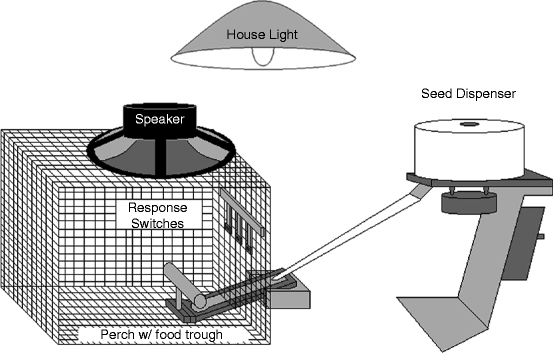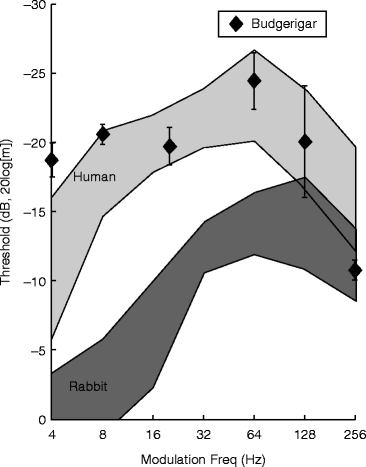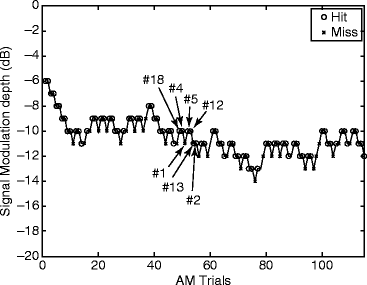Fig. 43.1
Comparison of AM detection thresholds for sinusoidally amplitude-modulated (SAM) wideband noise across several species. More sensitive thresholds appear higher on the plot. Thresholds in three bird species (circles) are generally comparable to human thresholds (squares). Rabbits and macaques are less sensitive to AM for wideband SAM stimuli similar to those used in the human studies. Thresholds in a one-interval task for human, budgerigar, and rabbit are highlighted by the solid symbols
In this study, AM detection thresholds for narrowband stimuli were estimated for the budgerigar, a vocal learner that has been used in a number of previous behavioral studies (e.g., Dooling and Searcy 1981; Dooling et al. 1989; Dent et al. 2002). Amplitude modulation detection thresholds for wideband noise stimuli (Dooling and Searcy 1981) suggested that the budgerigar’s sensitivity for SAM noise is comparable to that of human. Therefore, it was hypothesized that the budgerigar would be sensitive to low-frequency amplitude-modulated tones.
In addition to estimating AM detection thresholds, performance of the budgerigar in a masked modulation detection task was studied. Responses were compared to results using the same stimuli in human and rabbit. This experiment was motivated by previous studies of masked modulation in human listeners (e.g., Strickland and Viemeister 1996; Ewert and Dau 2000; Ewert et al. 2002; Nelson and Carney 2006). However, the use of reproducible narrowband noises as modulation maskers allows detailed comparisons of hit and false-alarm rates across masker waveforms as a means of identifying cues used in this detection task.
2 Methods
AM detection thresholds of budgerigar were estimated for SAM tones. Four English budgerigars were tested using a 4-kHz tone carrier modulated at frequencies ranging from 4 to 256 Hz. Stimuli were presented at 50 dB SPL.
Operant methods were used with a single-interval two-down, one-up (2D1U) adaptive tracking procedure (Levitt 1971) to estimate AM detection thresholds. Correct responses were reinforced by delivery of a single hulled millet seed. Incorrect responses were followed by a 5-s timeout with the house light extinguished. Bias was monitored throughout each session and was controlled by the delivery of two seeds for the responses on the side that was biased against for a percentage of trials that depended on the degree of bias. Sessions of approximately 250 trials were typically 10–20 min in duration and were conducted twice a day. Threshold estimates were based on the average of an even number of reversals over the last half of each track that had bias less than 0.3 and a standard deviation of modulation depth less than 3 dB.
The operant testing was done in the behavioral setup shown in Fig. 43.2. A row of three switches was mounted on the end of the enclosure. The speaker was mounted overhead. The bird started each trial by making an observing response on the center switch which initiated an acoustic stimulus. A correct reporting response for the standard stimulus was a peck on the left switch, and for the target stimulus, on the right switch. Each block of ten trials consisted of a random sequence of five modulated and five unmodulated trials, to avoid long runs of either trial type that could result in short-term bias.


Fig. 43.2
Schematic diagram of behavioral test setup. The dimensions of the enclosure are 23 cm on each side. This apparatus was housed in a small sound-proof booth, the inner walls of which were lined with sound-absorbing foam
3 Results
3.1 AM Detection Thresholds
At low modulation frequencies, the average AM detection thresholds for budgerigar were comparable to those of human listeners in a matched task (Fig. 43.3). At these frequencies, rabbits had the most difficulty in detecting modulation.


Fig. 43.3
AM detection thresholds of budgerigar (n = 4, for 4–64 Hz; n = 2 for 128 and 256 Hz). Budgerigar (diamonds) thresholds for SAM tones with 4 kHz carriers are superimposed on threshold ranges for humans (n = 3) and Dutch-belted rabbits (n = 5) using matched stimuli and methods. Thresholds are plotted as 20 log(m); more sensitive thresholds appear at the top of the plot. Means across birds +/− standard deviation are plotted. All stimuli were presented at 50 dB SPL
3.2 Masked Modulation Detection
Masked AM detection was studied using reproducible noises as modulation maskers. Stimuli were matched to those in a previous study of human listeners (Nelson and Carney 2006). The target modulation was 64-Hz SAM. Stimuli were generated by adding a 64-Hz sinusoid to a noise masker that was then used to modulate a 4-kHz tone carrier. The noise maskers consisted of a set of 20 reproducible (“frozen”) noises, created using a 32-Hz wide Gaussian noise centered at 64 Hz. The root mean square, RMS, level of the modulation masker was 13 dB below the RMS level of a tone modulator giving 100 % modulation. This level was selected to elevate modulation detection thresholds approximately 6 dB with respect to unmasked thresholds. Stimulus level was 65 dB SPL. Masker waveforms were randomly selected for each trial from the ensemble of 20 maskers, while the AM detection threshold was estimated using a 2DIU paradigm. The combined reproducible noise and 2D1U tracking test procedures are illustrated in Fig. 43.4.


Fig. 43.4




Illustration of a 2D1U track with reproducible noise masker. Noise IDs are indicated for a few of the trials. Trials near threshold were sorted by noise ID to compute hit and false-alarm rates for each masker noise waveform in the ensemble, as follows: The distribution of modulation depths (omitting the initial 1/3 of the track) was computed for each animal. Hit rates (correct detections) and false-alarm rates were computed for each reproducible masker based on trials that had modulation depths within one standard deviation of the mean depth over the latter 2/3 of the track. False-alarm trials were assigned to the modulation depth of the nearest preceding modulated trial
Stay updated, free articles. Join our Telegram channel

Full access? Get Clinical Tree


